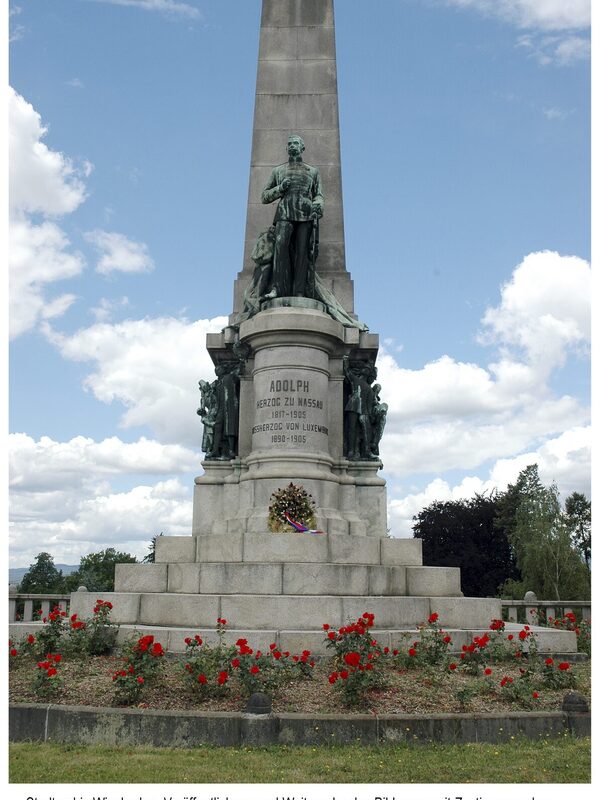Nassau state monument
In 1909, the Nassau State Monument, designed by sculptor Fritz Gerth, was inaugurated on the avenue between Biebrich and Wiesbaden.
In the 1890s, the idea of dedicating a monument to the last reigning sovereign, Duke Adolf von Nassau, arose in various places in the former Duchy of Nassau. At that time, the memory of Nassau's past had been brought back into people's consciousness.
Two committees were formed in Biebrich and Wiesbaden to realize the idea. Everyone agreed that they wanted to erect a monument to the former sovereign, but they could not agree on where it should be located. The Wiesbadeners argued for Wiesbaden as the former capital and residence of the duchy, while the Biebrichers argued for their town, as the duke had been born in Biebrich Palace on July 24, 1817.
It was the duke's death on November 17, 1905 that brought the parties together. At the end of 1905, a joint memorial committee was formed. In February 1906, it was decided that the monument should be erected on the avenue from Biebrich to Wiesbaden. In the meantime, the idea of erecting a personal monument to the former sovereign had been changed in favor of a general state monument that would commemorate the entire Nassau princely house and its past.
The new memorial committee now had the task of raising the necessary funds. At the time, every municipality and every district considered it a special honor to donate to the monument. The total cost of 130,856 marks was thus completely covered by donations from the Nassau region.
The Berlin-based sculptor Fritz Gerth, a native of Wiesbaden, was commissioned to design the monument. It had been hoped that the inauguration could take place as early as July 1908, but the date had to be postponed again and again. Finally, October 26, 1909 was the day.
The inauguration took place in the presence of Hereditary Grand Duchess Marie Adelheid - Grand Duchess of Luxembourg from 1912 to 1919 - and Princess Charlotte of Luxembourg - Grand Duchess of Luxembourg from 1919 to 1964 - the granddaughters of Duke Adolf, as well as Prince August Wilhelm of Prussia as the representative of Kaiser Wilhelm II. To everyone's regret, Grand Duchess Adelheid Marie, Duke Adolf's widow, his daughter-in-law Maria Anna and his daughter Hilda, the Grand Duchess of Baden, canceled their attendance.
The Nassau flag was raised above the rotunda of Biebrich Palace for the last time, and a glittering reception was held there once again after the inauguration of the monument.
The ceremony was framed by singing performances. After the unveiling, the monument was handed over to the town of Biebrich. Lord Mayor Rudolf Vogt ceremoniously took the monument into the care of the town.
The monument covers an area of around 1100 square meters. It consists of a substructure about seven meters high, on which an eight-meter-high obelisk rises, which serves as a backdrop for the four-meter-high portrait figure of the duke. The total height is therefore 15 meters. The base and obelisk are made of Odenwald granite and all the figures are made of bronze.
The larger-than-life statue of the Duke stands on a pedestal protruding from the base of the obelisk. Duke Adolf is depicted in a Nassau general's uniform, aged around 50. His left hand is resting on his sabre and he is holding a button on his coat with the thumb of his right hand. His right leg is slightly forward. Behind him lies the coat, slightly thrown over a pedestal. The actual base of the obelisk is surrounded on three sides by a frieze whose life-size figures symbolize a tribute to the Nassau people in various traditional costumes as well as Nassau soldiers in various uniforms. You can recognize a young woman in the traditional costume of Usingen, a farmer's boy from the Taunus, Westerwald farmers and a simple farmer's wife from the Goldener Grund. The back of the monument shows an ideal figure, the Fama, proclaiming the glory of the land. Two female figures sit at her feet: Love and Loyalty. The sculptor has also designed a mighty Nassau lion as the artistic conclusion to the base. The Nassau coat of arms can be seen on the lining wall. The dedication on the front reads: "Adolph - Duke of Nassau 1817-1905"; the dedication on the back reads: "To the Nassau Princely House in love and veneration. The grateful people 1909." The state monument survived the two world wars. Although the monument and the friezes were removed at the end of the Second World War to be taken to a foundry and melted down, they were saved. Even the occupying troops did not touch it.
Today, the national monument has taken on a new significance. At the suggestion of the Luxemburger Freundeskreis Rhein-Main e.V., the inscription "Adolph Herzog zu Nassau 1817-1905" was replaced by "Grand Duke of Luxembourg 1890-1905" in 1985. The Nassau State Monument has thus become a monument that points to the European dimension of the House of Nassau and its history.
Literature
Centenary of the Nassau State Monument: Monument to Duke Adolph of Nassau, Grand Duke of Luxembourg (1817-1905), September 26, 2009, Wiesbaden 2009.
